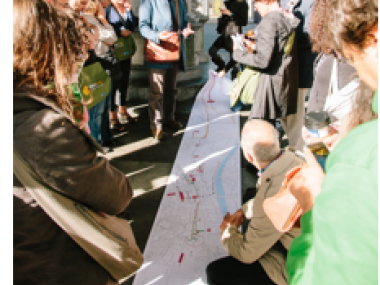Beyond Exchange and Learning… URBACT Cities Delivering!
Edited on
09 October 2017What happens once URBACT projects end? What concrete results can we expect after 3 years of exchange and learning at transnational level? Are the action plans produced by the cities implemented or end up in the drawers as we sometimes fear? Melody Houk, URBACT II Projects & Capitalisation manager answers these questions for us.

The URBACT II programme is primarily aiming to support European cities in developing integrated action-plans for sustainable urban development. Transnational networking in URBACT is designed to allow cities facing common challenges to share experience and practices, and to learn from one another, in the perspective of improving local policies. Yet URBACT does not finance investments, neither pilot projects, nor… the local actions plans that are produced by all network partners. Even though this was a given in the way the programme was initially built, sponsors often question the capacity of the programme to promote integrated sustainable urban development: what becomes of the Local Action Plans once they have been produced and once a network is over after 3 years of transnational cooperation? Well, the good news is that cities do manage to secure funds and deliver!
Most URBACT action plans reaching the implementation stage
When European cities joined the URBACT II programme within the framework of the 1st call for proposals launched in 2008, they were to experience a new framework. Beyond getting involved in transnational exchange networks, they had to ensure that the learning taking place in transnational seminars and the lessons drawn from these exchanges would be embedded in enhanced local policies and practices through the production of an integrated local action plan. The question of the actual impact on local policies and practices was often raised as cities were anticipating difficulties to secure funding. According to a recent study on the Local Action Plans produced by the 180 partners involved in networks of the 1st call, a large majority of these local action plans do come to life. Consulted by means of an online questionnaire one year after the end of their network, 90% of respondent cities declare their Local Action Plan was actually being implemented. And one third of these respondents declare having implemented over 50% of the actions outlined in their action plan. This is a very positive outcome considering the fact that there was no institutional bridge between the Local Action Plans to be produced by partners involved in URBACT networks and the Structural funds possibly available in the Operational Programmes (especially ERDF). While in some cases, specific funds for urban development were simply not provisioned in the Operational Programmes, in other cases, these funds had already been allocated when the Local Action Plans were finalised early 2011. Subsequently, URBACT partners struggled to find a route to funding and implementation, in a context where financial resources were getting scarcer and scarcer. Moreover, the online survey provides a rather positive perspective for the coming years, as 72% respondents having already implemented some actions believe that their action plan will be fully implemented in the future. These positive trends are confirmed by a survey conducted late spring 2013 among partners of the 2nd round of networks. Only 3 months after they had completed their activities and delivered their Local Action Plans, 75% of all 90 partners were reporting they had started to implement their action plans.
Most Local Action Plans drawing on local and national funding schemes
When it comes to funds secured for the implementation of these URBACT action plans, local and regional funding appear to be the most frequently reported source. Yet Structural Funds have been levered as well: 25% respondents report the use of Structural Funds in the delivery of their Action Plans, with a large predominance of ERDF (mentioned by 22% respondents versus 3% only reporting the use of ESF). This is to be considered as a positive achievement considering that the Local Action Plans have been delivered in 2011 when several Operational Programmes were already fully committed or with very little resources left. It is worth underlining that, in more than 50% of the cases, ERDF has been used to support projects for local economic development and jobs related actions. Only in few cases, all situated in EU12 Member States, ERDF has been used to finance major infrastructural investments (e.g. water and waste management system in Zabrze, Poland). When it comes to ESF, it is interesting to notice that only 3% partner cities declare having secured ESF whereas one-third of the 1st call networks had an explicit focus on social issues. Interestingly enough, the cities having secured ESF funds have also secured ERDF funds for the implementation of their action plans. In total, more than 105 million euros have been levered for sustainable urban development projects by partners involved in the 1st round of URBACT networks (2008-2011). While this includes a major regeneration project implemented in Bialystok (Poland) for the creation of a science park with a 40 million euros budget, it does not include other achievements in cities that did not take part to the survey so the global picture is actually wider. Really encouraging results at a time when we are preparing the next generation of the URBACT programme! Melody Houk, URBACT II Projects & Capitalisation manager
For more details on Local Action Plans produced under the 1st round of URBACT networks, see:
- Results of the URBACT Projects – URBACT website
 Download LAP_Study_Implement_Nov_2013_01.pdf (211.45 KB)– URBACT website
Download LAP_Study_Implement_Nov_2013_01.pdf (211.45 KB)– URBACT website
Submitted by admin on
